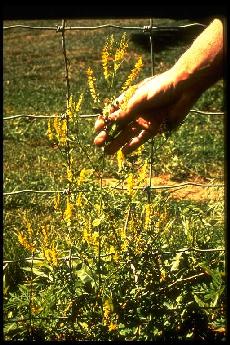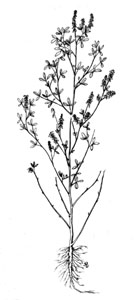YELLOW SWEETCLOVER WHITE SWEETCLOVER
Melilotus officinalis Melilotus alba


(pea family)
TOXICITY RATING: Moderate.
ANIMALS AFFECTED: All animals that eat affected hay may be poisoned.
DANGEROUS PARTS OF PLANTS: All above-ground parts when present in moldy hay.
CLASS OF SIGNS: Bruising, spontaneous bleeding.
PLANT DESCRIPTION: These coarse biennial herbs (fig. 16) have alternate, three-parted, toothed leaves and bear white or yellow flowers in long, slender, spike-like clusters in the leaf axils. The numerous small, pea-like, white or yellow flowers fall soon after blooming. Pods are small, egg-shaped to round, inflated, and contain 1 to 4 seeds. Sweetclover grows along roadsides, fence rows, and in old fields. It is cultivated as a forage crop and soil builder. The plants favor alkaline or calcareous soils.
SIGNS: Clinical signs are related to the anticoagulant ("prevents blood clotting") activity of dicoumarol (also called dicoumarin). Coumarin, present in sweet clover, is converted to dicoumarin during improper curing of sweet clover hay, or when the plant is excessively stressed (frosts, drought). Fresh, undamaged sweetclover is safe for consumption.
Signs are related to the consumption and inadequate production of vitamin K, responsible for blood clotting, therefore excessive and uncontrolled bruising and bleeding will occur. The bleeding may be noticeable (through the nose, mouth or a wound), or may occur under the skin as large bruises, but can also occur inside the body, making an accurate diagnosis more difficult. The toxin can be passed in the milk, therefore nursing animals may be affected. The moldy hay needs to be consumed for 2 weeks or longer before signs manifest and this toxicosis is most often seen in winter after several weeks of moldy sweetclover has been consumed and is typically a herd problem.
Affected animals are weak, anorexic, may exhibit visible bleeding, have pale mucus membranes, increased respiratory rates, rapid and weak pulses, and may die. Often more than one animal is affected at a time.
Dicoumarin and related drugs are used in human medicine as "blood thinners" and are commonly used in rat and mouse poisons (which if ingested by any other animal can cause excessive bleeding and death if not treated).
FIRST AID: Remove all moldy hay from the animals. A veterinarian needs to be called if animals are bleeding, although once bleeding starts, it may be difficult to save the animal. Treatments can include blood or plasma transfusions (which may not be available or practical with large numbers of livestock) or treatment with vitamin K1. Vitamin K1 therapy requires a minimum of 12 to 24 hours to be effective, therefore severely affected animals may not survive this time period.
PREVENTION: Toxicity can be prevented by properly curing sweet clover hay, especially by allowing the stems to dry before baling. Extra caution must be taken with second year growth, since it contains a higher concentration of toxin. Affected hay may remain toxic for years. Moldy sweet clover hay should not be fed, but if it has to be fed, alternating with a non-moldy quality hay every few days will minimize clinical signs. Moldy sweet clover hay should be withheld for 4 to 6 weeks prior to anticipated parturition ("giving birth") or surgical procedure, to lessen the chances of these animals bleeding to death. Discard milk from affected animals to prevent signs developing in nursing animals.
![]()
![]()
Back to Plants
 Wildflower
Seed For Sale
Wildflower
Seed For Sale